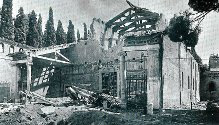Although I've only visited the Italian region of Le Marche once, and only the city of Urbino (the above photo is one of the towers in the Ducal palace) I'd love to know it better. I recently interviewed my friend Giulia Savini, who lives near Urbino, about the region's appeal (these are also her photos.)
It seems that visitors to Italy seeking an authentic experience, away from
tour buses and camera flashes, are turning to the stunning beauty of
Le Marche region. Below is a photo of the hilltop town of Mondavio.
Stretching from the
6,000-foot peaks of central Italy's Apennines on the border of
Tuscany and Umbria, Le Marche reaches across to the Adriatic sea.
Its land is hilly and even mountainous,
with plenty of agricultural fields dotted with stunning hill towns,
curving rural roads, and even crowded summer beaches snaking along
200 kilometers of coastline.
Surprisingly few tourists make their way to Le Marche, despite its numerous art treasures,
carefully preserved historic churches, towers, and piazzas, all
giving the region the air of being frozen in time. Below is Sant'Ippolito.
"Something that makes
Le Marche so special is that we are really off the beaten path,"
says Giulia, who runs an organic farm with bed and breakfast
Locanda della Valle Nuova, 12 kilometres outside the region's best
known city, Urbino.
"People here are not
fed up with tourists".
(Here's a photo I recently shot of Giulia, on the right, and Letizia Mattiacci of Alla Madonna del Piatto in Umbria. We met at Letizia's house. As you can see, they were up to something.....)
Many Le Marche visitors head to
Urbino, where the walled city centre has been declared a UNESCO World
Heritage Site.
Birthplace of Renaissance
master painter Raphael, Urbino is also known as an early model for
the ideal Renaissance town, remade as such by Duke Federico of
Montefeltro during the 15th century.
His court was famous in
its day and the countryside is today still dominated by his
magnificent Ducal Palace - which holds the region's most important
art gallery, boasting works painted by Raphael and Piero della
Francesca. Below is one of Giulia's photos of a XII century castle perched on a steep hill above the Candigliano river between Acqualagna and Piobbico.
Churches and monasteries
hold beautiful art endowed by the wealthy families that were drawn to
the duke's court, and Raphael's home is open to art lovers keen to
see a fresco painted on the house walls by the artist as a very young
man.
Still, Le Marche is less
of an urban experience and more about stunning landscapes, important
nature preserves, hidden monasteries, and charming villages.
For example, visitors can
explore the Grotte di Frasassi (Frasassi Caves), among the biggest in
Europe, including a chamber which is large enough to hold Milan's
great cathedral; or, hike in the beautiful Riserva Naturale Gola del
Furlo (Furlo Gorge).
"We have many great
sites, but they're all spread around so the region attracts the kind
of visitor who wants to really 'live' a place and not just have a
list of must-sees from a more fashionable place," adds Giulia.
The region is also about
wine and food: traditional dishes produced and prepared in the
old-fashioned way but rediscovered by modern cooks looking for
natural, clean ingredients.
Because Le Marche is
fairly unknown, land here was relatively cheap in the 1970s and early
1980s, bringing waves of young producers - including Giulia's family
- interested in clean production that would leave as small an
environmental footprint as possible.
It's still possible to
find heirloom fruits in Le Marche - varieties that have disappeared
or been forgotten in other regions. Certain farmers in the
Montefeltro area in northern Le Marche specialize in forgotten fruits
including visciole, sorbe, mele rosa, and pere angelica.


















































